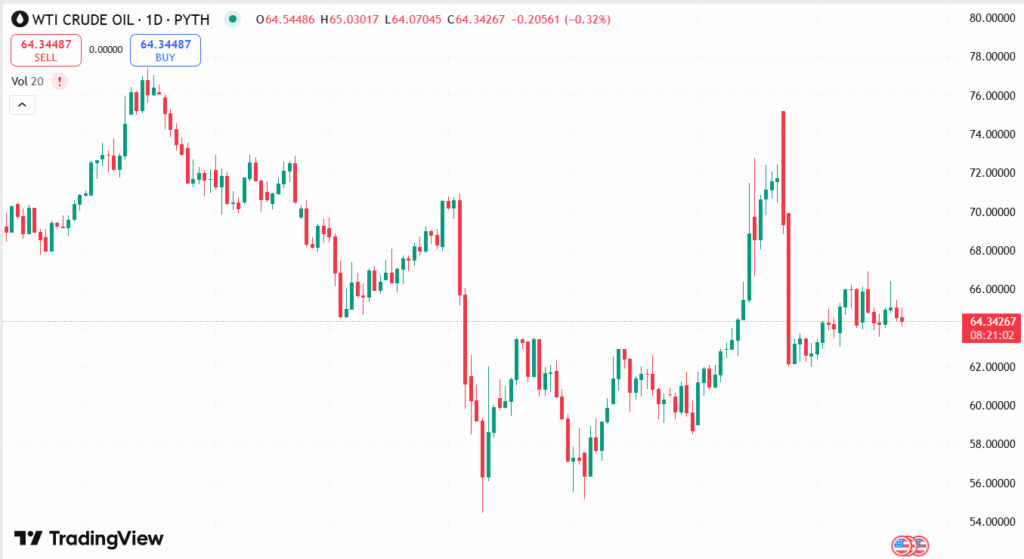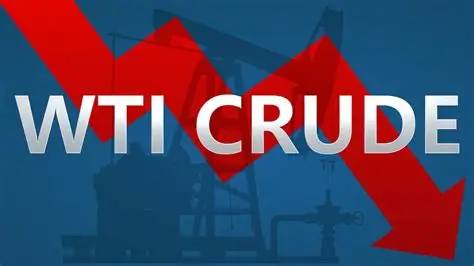West Texas Intermediate (WTI) crude oil prices continued their third consecutive session of losses, falling to about $65.50 due to growing global trade tensions and weakening supply worries. Market sentiment remains subdued as investors wait for news of US-EU trade talks in the lead-up to President Trump’s impending August 1 tariff deadline. The prospect of new tariffs and EU retaliation has added to fears of global demand. In the meantime, the signing of a $8 billion refinery accord between Indonesia and KBR Inc., increasing oil exports out of Saudi Arabia, and reducing Middle Eastern geopolitical tensions have also weighed on oil prices.
KEY LOOKOUTS
• Markets wait to see developments before the August 1 tariff target date imposed by President Trump, potentially affecting worldwide oil demand.
• The $8 billion deal can affect US tariff policy and alter regional supply balances.
• Rising production from big producers such as Saudi Arabia puts downward pressure on oil prices.
• The Israel-Iran ceasefire and revived nuclear talks with Europe decrease geopolitical risk and supply interruptions.

WTI crude oil prices sank to almost $65.50 as sustained trade tensions between the US and EU continue to fuel worries about slowing global demand. The markets are closely watching developments prior to President Trump’s August 1 tariff deadline, which may prompt retaliatory actions by the European bloc. Furthermore, relaxing Middle Eastern geopolitical tensions and increasing production by major producers such as Saudi Arabia are also fueling oversupply concerns. Recent $8 billion refinery agreement between Indonesia’s Danantara and US-based KBR Inc. also contributed to lower proposed US tariffs, further influencing market sentiment.
WTI crude oil falls to approximately $65.50 in response to growing US-EU trade tensions and abating supply worries. Traders are tentative ahead of the August 1 tariff, while increasing Saudi exports and lower geopolitical risks contribute to the price pressure downwards.
• WTI crude oil falls to $65.50, its third straight session of decline.
• US-EU trade tensions rise, with President Trump signaling 30% tariffs on EU imports.
• Investors look for news on trade talks ahead of the August 1 deadline.
• Indonesia signs an $8 billion contract with KBR Inc. to construct 17 modular refineries, affecting tariff realignments.
• Saudi oil exports surge to a three-month high, exacerbating supply pressure.
• Israel-Iran ceasefire and revived nuclear talks with Europe alleviate Middle East geopolitical tensions.
• Demand prospects falter, as oversupply worries and uncertainty of trade encumber market sentiment.
West Texas Intermediate (WTI) crude oil is struggling as tensions in international trade create apprehensions regarding future energy demand. The oil market keeps its close eye on any development between the United States and the European Union, particularly as President Trump’s August 1 tariff deadline draws near. The threat of a 30% tariff on EU exports has led to the European bloc looking to retaliate, creating uncertainty in the global trade environment. This has resulted in investors becoming more risk-averse, as ongoing trade tensions between large economies could affect industrial production and fuel consumption globally.
WTI CRUDE OIL DAILY PRICE CHART

SOURCE: TradingView
Beyond the trade uncertainty, geopolitical concerns are also dictating the oil market narrative. Indonesia’s Danantara sovereign fund is pushing ahead with a large $8 billion refinery venture in association with U.S.-based KBR Inc., a development that has prompted a drop in planned U.S. tariff rates. At the same time, pressures on oil supplies are building, with Saudi Arabia posting its three-month high export levels. Middle East tensions have eased somewhat after the ceasefire between Israel and Iran, and Iran has indicated it intends to reopen nuclear talks with European states with an eye to reinstating the 2015 agreement and minimizing the chances of resumption of sanctions.
TECHNICAL ANALYSIS
WTI crude oil is showing a distinct bearish trend after it broke below critical support levels and now trades around $65.50. The price remains below its 50-day and 200-day moving averages, pointing to continuation of the downtrend. Momentum oscillators such as the Relative Strength Index (RSI) indicate that the commodity is close to oversold levels, but not yet indicating a reversal. Unless buying interest picks up strongly or positive geopolitical news arises, WTI can still probe lower support levels around $64.50 and $63.00 in the immediate term.

FORECAST
WTI crude oil might get some support if negotiations on trade between the EU and the US turn in its favor, alleviating concerns of slowing demand. A concluded agreement or postponement of threatened tariffs would also revive some investor sentiment and push prices higher. Furthermore, any sudden supply disruptions—by way of geopolitical tensions or OPEC+ cuts—would give impetus to the upside, sending prices back into the $68–$70 range in the near term.
On the negative side, if trade tensions worsen or no agreement is met before the August 1 deadline, oil demand prospects could decline sharply, putting downward pressure on prices. Increased production from key producers such as Saudi Arabia and the softening of tensions in the Middle East are also driving a market oversupply. If this trend continues, WTI may experience losses further, potentially falling below $64, with the next significant support at $62.50.







